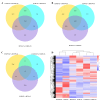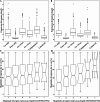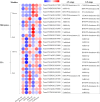Transcriptome dynamics and allele-specific regulation underlie wheat heterosis at the anthesis and grain-filling stages
- PMID: 40898053
- PMCID: PMC12403350
- DOI: 10.1186/s12864-025-11983-2
Transcriptome dynamics and allele-specific regulation underlie wheat heterosis at the anthesis and grain-filling stages
Abstract
Background: As wheat is a globally important staple crop, the molecular regulatory network underlying heterosis in wheat remains incompletely understood. The flag leaf is the primary source of photoassimilates during grain filling and plays a crucial role in yield formation. However, the genetic mechanisms linking flag leaf development to heterosis are still unclear.
Results: Transcriptomic analysis revealed dynamic transcriptional reprogramming during the anthesis to grain-filling transition, with a pronounced expression bias toward superior parental alleles in hybrids. Anthesis-stage non-additive dominance and grain-filling-stage additive enhancement synergistically orchestrated the temporal regulatory shift underlying heterosis. The dominant alleles from the superior parent accounted for more than 60% of the non-additive genes, and the superior parent bias in allele-specific expression ratios progressively increased during development. This highlighted the role of the superior parent as an allelic reservoir. Cis-regulatory variations primarily contributed to additive effects, whereas cis×trans interactions were the primary regulatory driver of positive overdominance. Notably, weighted co-expression network analysis identified HSP90.2-B as a putative heterosis-related gene, whose coordinated overexpression with AP2/ERF transcription factors provides valuable insights for elucidating the molecular basis of yield heterosis.
Conclusions: This study establishes two complementary models to decode the molecular regulation of heterosis in wheat. The "dual-engine" model demonstrates stage-specific gene expression patterns: non-additive effects predominantly drive early growth vigor during the anthesis stage, whereas additive expression patterns stabilize grain development and yield-related traits at the grain-filling stage. The "two-phase regulatory shift" model captures the dynamic temporal progression of heterotic regulation, evolving from trans-regulation-driven plastic responses at the anthesis stage to cis-regulation-mediated homeostatic control at the grain-filling stage. Importantly, the preferential coupling between cis-regulation/additive and trans-regulation/non-additive expression provides molecular evidence supporting the complementary nature of the models. We further identified developmentally specific modules (the anthesis-stage Red module and grain-filling-stage Brown module) with their core regulatory networks through weighted gene co-expression network analysis. These findings preliminarily characterize the multi-layered cooperative networks regulating heterosis development, potentially offering valuable theoretical clues for deciphering the molecular mechanisms underlying wheat heterosis.
Keywords: Cis- and trans-regulation; HSP90.2-B; Triticum aestivum L.; Additive and non-additive expression patterns; Allele-specific expression; Heterosis; Transcriptome; Weighted gene co-expression network analysis.
© 2025. The Author(s).
Conflict of interest statement
Declarations. Ethics approval and consent to participate: Not applicable. Consent for publication: Not applicable. Competing interests: The authors declare no competing interests.
Figures









Similar articles
-
Proteomic profiling reveals important regulators of photosynthate accumulation in wheat leaves during grain development.BMC Plant Biol. 2025 Jul 2;25(1):810. doi: 10.1186/s12870-025-06745-x. BMC Plant Biol. 2025. PMID: 40604394 Free PMC article.
-
Transcriptomic insights into grain size development in naked barley (Hordeum vulgare L. var. nudum Hook. f): based on weighted gene co-expression network analysis.PeerJ. 2025 Aug 8;13:e19856. doi: 10.7717/peerj.19856. eCollection 2025. PeerJ. 2025. PMID: 40792006 Free PMC article.
-
Translational landscape provides insight into the molecular mechanism of heterosis in inter-subspecific hybrid rice.Plant J. 2025 Jun;122(6):e70297. doi: 10.1111/tpj.70297. Plant J. 2025. PMID: 40552675
-
Systemic pharmacological treatments for chronic plaque psoriasis: a network meta-analysis.Cochrane Database Syst Rev. 2021 Apr 19;4(4):CD011535. doi: 10.1002/14651858.CD011535.pub4. Cochrane Database Syst Rev. 2021. Update in: Cochrane Database Syst Rev. 2022 May 23;5:CD011535. doi: 10.1002/14651858.CD011535.pub5. PMID: 33871055 Free PMC article. Updated.
-
Systemic pharmacological treatments for chronic plaque psoriasis: a network meta-analysis.Cochrane Database Syst Rev. 2020 Jan 9;1(1):CD011535. doi: 10.1002/14651858.CD011535.pub3. Cochrane Database Syst Rev. 2020. Update in: Cochrane Database Syst Rev. 2021 Apr 19;4:CD011535. doi: 10.1002/14651858.CD011535.pub4. PMID: 31917873 Free PMC article. Updated.
References
-
- Liu W, Zhang Y, He H, He G, Deng X. From hybrid genomes to heterotic trait output: challenges and opportunities. Curr Opin Plant Biol. 2022;66:102193. - PubMed
-
- Duvick DN. Biotechnology in the 1930s: the development of hybrid maize. Nat Rev Genet. 2001;2(1):69–74. - PubMed
-
- Longin CFH, Mühleisen J, Maurer HP, Zhang H, Gowda M, Reif JC. Hybrid breeding in autogamous cereals. Theor Appl Genet. 2012;125(6):1087–96. - PubMed
MeSH terms
LinkOut - more resources
Full Text Sources
Research Materials

